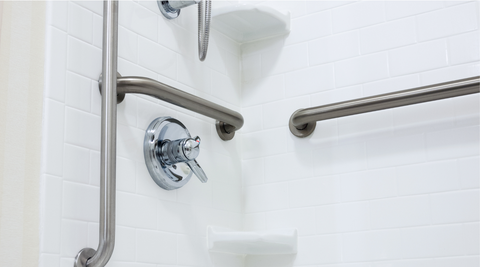
Grab Bars: Types and Reasons to Install Them in Your Bathroom
According to the Centers for Disease Control and Prevention (CDC), over 235,000 people aged 15 and above visit emergency rooms annually due to injuries sustained in the bathroom. Fortunately, installing grab bars is an effective way to enhance bathroom safety, prevent falls, and support people with mobility issues.
This article will discuss why you need to grab bars in your bathroom and the different types available.
Why Grab Bars Are Essential in Bathrooms
Enhances Stability and Comfort
People with balance issues frequently need more confidence in every step, especially if they have had a previous fall.
When stability is an issue, a misstep is more likely, which might lead to another fall. Bathrooms are among the most dangerous rooms in a house since the floor can be slick, and they are only sometimes cultivated and airy.
Prevents Slip-and-Fall
Even for persons who do not have mobility issues, getting out of the bathtub or shower can result in an accident. It just takes one fall to have catastrophic long-term implications, but you can avoid this by adding grab bars in the shower and outside.
They are significantly stronger and sturdier than towel bars, so grasping them can help you regain stability and prevent falls. Elders who live alone at home can enjoy better peace of mind when using the restroom alone.
Promotes Independence
Being unable to live independently is one worry the elders living at home regularly have. Even simple activities like using the restroom or getting in and out of the shower occasionally call for assistance.
However, a little bathroom upgrade, such as grab bars placed in useful places, can promote independent living and enable elders to complete more tasks independently.
Types of Grab Bars
Wall-Mounted Grab Bars
Wall-mounted grab bars are the most common type of grab bars. They are attached to the wall using screws and anchors and are available in different lengths and styles.
Moreover, wall-mounted grab bars can be installed in various locations, such as beside the toilet, in the shower, or near the bathtub.

Floor-To-Ceiling Grab Bars
Floor-to-ceiling grab bars are installed from the floor to the ceiling and do not require attachment to the wall. They are ideal for people who need additional support and stability or cannot drill into the walls. Floor-to-ceiling grab bars also benefit people who rent their homes and cannot permanently modify the walls.
Suction Cup Grab Bars
Suction cup grab bars are temporary grab bars that attach to the surface using suction cups. They are easy to install and remove, making them ideal for people who travel or those who want to avoid permanent modifications to their bathrooms. Suction cup grab bars are less sturdy than wall-mounted or floor-to-ceiling grab bars, so they are not recommended for primary support.
Flip-up Grab Bars
Flip-up grab bars are wall-mounted grab bars that can be flipped up and out of the way when unused. They are ideal for people who need additional support but do not want a permanent grab bar obstructing their bathroom space. Flip-up grab bars are also helpful for caregivers who must assist their loved ones with personal hygiene tasks.
Conclusion
Installing grab bars in your bathroom is a simple yet effective way to enhance safety, prevent falls, and support people with mobility issues. With different types of grab bars available, you can choose the one that best suits your needs and preferences.



